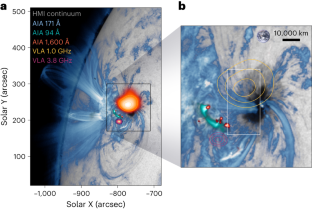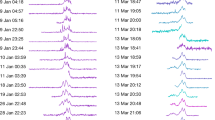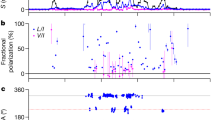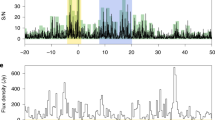Abstract
Auroral radio emissions in planetary magnetospheres typically feature highly polarized, intense radio bursts, usually attributed to electron cyclotron maser emission from energetic electrons in the planetary polar region that features a converging magnetic field. Similar bursts have been observed in magnetically active low-mass stars and brown dwarfs, often prompting analogous interpretations. Here we report observations of long-lasting solar radio bursts with high brightness temperature, wide bandwidth and high circular polarization fraction akin to these auroral and exo-auroral radio emissions, albeit two to three orders of magnitude weaker than those on certain low-mass stars. Spatially, spectrally and temporally resolved analysis suggests that the source is located above a sunspot where a strong, converging magnetic field is present. The source morphology and frequency dispersion are consistent with electron cyclotron maser emission due to precipitating energetic electrons produced by recurring nearby flares. Our findings offer new insights into the origin of such intense solar radio bursts and may provide an alternative explanation for aurora-like radio emissions on other flare stars with large starspots.
This is a preview of subscription content, access via your institution
Access options
Access Nature and 54 other Nature Portfolio journals
Get Nature+, our best-value online-access subscription
$29.99 / 30 days
cancel any time
Subscribe to this journal
Receive 12 digital issues and online access to articles
$119.00 per year
only $9.92 per issue
Buy this article
- Purchase on Springer Link
- Instant access to full article PDF
Prices may be subject to local taxes which are calculated during checkout





Similar content being viewed by others
Data availability
The data that support the plots and other findings within this paper are available at https://data.nrao.edu/portal (VLA; Project ID: 16A-377), https://www.sws.bom.gov.au/World_Data_Centre (RSTN), https://solar.nro.nao.ac.jp/norp (NoRP), https://www.swpc.noaa.gov/products/goes-x-ray-flux (GOES) and http://jsoc.stanford.edu (SDO), or from the corresponding author upon reasonable request.
Code availability
The magnetic field extrapolation56 software packages are available through IDL SolarSoft at https://sohowww.nascom.nasa.gov/solarsoft. The regularized inversion code for differential emission measure (DEM) calculation63 is available at https://github.com/ianan/demreg. Public software packages used in this study include SunCASA https://github.com/suncasa/suncasa-src, CASA64https://casa.nrao.edu, SunPy65https://sunpy.org and Astropy66https://www.astropy.org.
References
Zarka, P. Auroral radio emissions at the outer planets: observations and theories. J. Geophys. Res. 103, 20159–20194 (1998).
Berger, E. et al. The magnetic properties of an L dwarf derived from simultaneous radio, X-ray, and Hα observations. Astrophys. J. 627, 960–973 (2005).
Hallinan, G. et al. Periodic bursts of coherent radio emission from an ultracool dwarf. Astrophys. J. Lett. 663, L25–L28 (2007).
Bastian, T. S., Cotton, W. D. & Hallinan, G. Radio emission from UV Cet: auroral emission from a stellar magnetosphere. Astrophys. J. 935, 99 (2022).
Hallinan, G. et al. Magnetospherically driven optical and radio aurorae at the end of the stellar main sequence. Nature 523, 568–571 (2015).
Zic, A. et al. ASKAP detection of periodic and elliptically polarized radio pulses from UV Ceti. Mon. Not. R. Astron. Soc. 488, 559–571 (2019).
Kao, M. et al. Magnetism in the brown dwarf regime. Bull. Am. Astron. Soc. 51, 484 (2019).
Benz, A. O., Conway, J. & Gudel, M. First VLBI images of a main-sequence star. Astron. Astrophys. 331, 596–600 (1998).
Kao, M. M., Mioduszewski, A. J., Villadsen, J. & Shkolnik, E. L. Resolved imaging of an extrasolar radiation belt around an ultracool dwarf. Nature 619, 272–275 (2023).
Berger, E. et al. Periodic radio and Hα emission from the L dwarf binary 2MASSW J0746425+200032: exploring the magnetic field topology and radius of an L dwarf. Astrophys. J. 695, 310–316 (2009).
Yu, S. et al. Modelling the radio pulses of an ultracool dwarf. Astron. Astrophys. 525, A39 (2011).
Kuznetsov, A. A. et al. Comparative analysis of two formation scenarios of bursty radio emission from ultracool dwarfs. Astrophys. J. 746, 99 (2012).
Carley, E. P. et al. Loss-cone instability modulation due to a magnetohydrodynamic sausage mode oscillation in the solar corona. Nat. Commun. 10, 2276 (2019).
Lemen, J. R. et al. The Atmospheric Imaging Assembly (AIA) on the Solar Dynamics Observatory (SDO). Sol. Phys. 275, 17–40 (2012).
Chen, B. et al. Measurement of magnetic field and relativistic electrons along a solar flare current sheet. Nat. Astron. 4, 1140–1147 (2020).
Benz, A. O. & Guedel, M. X-ray/microwave ratio of flares and coronae. Astron. Astrophys. 285, 621–630 (1994).
Melrose, D. B. & Dulk, G. A. Electron-cyclotron masers as the source of certain solar and stellar radio bursts. Astrophys. J. 259, 844–858 (1982).
Treumann, R. A. The electron-cyclotron maser for astrophysical application. Astron. Astrophys. Rev. 13, 229–315 (2006).
Chen, B. et al. Magnetic reconnection null points as the origin of semirelativistic electron beams in a solar jet. Astrophys. J. 866, 62 (2018).
Battaglia, M. et al. Multiple electron acceleration instances during a series of solar microflares observed simultaneously at X-rays and microwaves. Astrophys, J. 922, 134 (2021).
Thomas, J. H., Cram, L. E. & Nye, A. H. Five-minute oscillations as a subsurface probe of sunspot structure. Nature 297, 485–487 (1982).
Yuan, D. et al. Transverse oscillations and an energy source in a strongly magnetized sunspot. Nat. Astron. 7, 856–866 (2023).
Liu, W. et al. A truly global extreme ultraviolet wave from the SOL2017-09-10 X8.2+ solar flare-coronal mass ejection. Astrophys. J. Lett. 864, L24 (2018).
Benz, A. O. Flare observations. Living Rev. Sol. Phys. 14, 2 (2017).
Krucker, S., Kontar, E. P., Christe, S. & Lin, R. P. Solar flare electron spectra at the Sun and near the Earth. Astrophys. J. Lett. 663, L109–L112 (2007).
Villadsen, J. & Hallinan, G. Ultra-wideband detection of 22 coherent radio bursts on M dwarfs. Astrophys. J. 871, 214 (2019).
Vedantham, H. K. et al. Coherent radio emission from a quiescent red dwarf indicative of star-planet interaction. Nat. Astron. 4, 577–583 (2020).
Callingham, J. R. et al. The population of M dwarfs observed at low radio frequencies. Nat. Astron. 5, 1233–1239 (2021).
Turnpenney, S., Nichols, J. D., Wynn, G. A. & Casewell, S. L. Auroral radio emission from ultracool dwarfs: a Jovian model. Mon. Not. R. Astron. Soc. 470, 4274–4284 (2017).
Owocki, S. P. et al. Centrifugal breakout reconnection as the electron acceleration mechanism powering the radio magnetospheres of early-type stars. Mon. Not. R. Astron. Soc. 513, 1449–1458 (2022).
West, A. A. et al. Constraining the age-activity relation for cool stars: the Sloan Digital Sky Survey Data Release 5 low-mass star spectroscopic sample. Astron. J. 135, 785–795 (2008).
France, K. et al. The MUSCLES Treasury Survey. I. Motivation and overview. Astrophys. J. 820, 89 (2016).
Robertson, P. et al. Persistent starspot signals on M dwarfs: multiwavelength Doppler observations with the Habitable-zone Planet Finder and Keck/HIRES. Astrophys. J. 897, 125 (2020).
Williams, P. K. G. et al. The first millimeter detection of a non-accreting ultracool dwarf. Astrophys. J. 815, 64 (2015).
Kao, M. M. et al. Auroral radio emission from late L and T dwarfs: a new constraint on dynamo theory in the substellar regime. Astrophys. J. 818, 24 (2016).
Lynch, C. et al. Radio detections of southern ultracool dwarfs. Mon. Not. R. Astron. Soc. 457, 1224–1232 (2016).
Pineda, J. S., Hallinan, G. & Kao, M. M. A panchromatic view of brown dwarf aurorae. Astrophys. J. 846, 75 (2017).
Kao, M. M., Hallinan, G., Pineda, J. S., Stevenson, D. & Burgasser, A. The strongest magnetic fields on the coolest brown dwarfs. Astrophys. J. Suppl. Ser. 237, 25 (2018).
Hallinan, G. et al. Confirmation of the electron cyclotron Maser instability as the dominant source of radio emission from very low mass stars and brown dwarfs. Astrophys. J. 684, 644–653 (2008).
Lynch, C. R., Lenc, E., Kaplan, D. L., Murphy, T. & Anderson, G. E. 154 MHz detection of faint, polarized flares from UV Ceti. Astrophys. J. Lett. 836, L30 (2017).
Das, B., Chandra, P. & Wade, G. A. Discovery of electron cyclotron MASER emission from the magnetic Bp star HD 133880 with the Giant Metrewave Radio Telescope. Mon. Not. R. Astron. Soc. 474, L61–L65 (2018).
Hallinan, G. et al. Rotational modulation of the radio emission from the M9 dwarf TVLM 513-46546: broadband coherent emission at the substellar boundary? Astrophys. J. 653, 690–699 (2006).
Berger, E. et al. Simultaneous multiwavelength observations of magnetic activity in ultracool dwarfs. I. The complex behavior of the M8.5 dwarf TVLM 513-46546. Astrophys. J. 673, 1080–1087 (2008).
Berger, E. et al. Simultaneous multiwavelength observations of magnetic activity in ultracool dwarfs. II. Mixed trends in VB 10 and LSR 1835+32 and the possible role of rotation. Astrophys. J. 676, 1307–1318 (2008).
Trigilio, C., Leto, P., Umana, G., Buemi, C. S. & Leone, F. Auroral radio emission from stars: the case of CU Virginis. Astrophys. J. Lett. 739, L10 (2011).
Ergun, R. E. et al. Electron-cyclotron Maser driven by charged-particle acceleration from magnetic field-aligned electric fields. Astrophys. J. 538, 456–466 (2000).
White, S. M., Thomas, R. J. & Schwartz, R. A. Updated expressions for determining temperatures and emission measures from GOES soft X-ray measurements. Sol. Phys. 227, 231–248 (2005).
Chen, B. Radio and X-ray diagnostics of energy release in solar flares. PhD thesis, Univ. of Virginia (2013).
Condon, J. J. Errors in elliptical gaussian fits. Publ. Astron. Soc. Pac. 109, 166–172 (1997).
Bastian, T. S. Angular scattering of solar radio emission by coronal turbulence. Astrophys. J. 426, 774 (1994).
Kontar, E. P. et al. Imaging spectroscopy of solar radio burst fine structures. Nat. Commun. 8, 1515 (2017).
Nakajima, H., Sekiguchi, H., Sawa, M., Kai, K. & Kawashima, S. The radiometer and polarimeters at 80, 35, and 17 GHz for solar observations at Nobeyama. Publ. Astron. Soc. Jpn 37, 163–170 (1985).
Berger, E. et al. Simultaneous multi-wavelength observations of magnetic activity in ultracool dwarfs. III. X-ray, radio, and Hα activity trends in M and L dwarfs. Astrophys. J. 709, 332–341 (2010).
Williams, P. K. G., Cook, B. A. & Berger, E. Trends in ultracool dwarf magnetism. I. X-ray suppression and radio enhancement. Astrophys. J. 785, 9 (2014).
Raymond, J. C. & Smith, B. W. Soft X-ray spectrum of a hot plasma. Astrophys. J. Suppl. Ser. 35, 419–439 (1977).
Wiegelmann, T. Optimization code with weighting function for the reconstruction of coronal magnetic fields. Sol. Phys. 219, 87–108 (2004).
Metcalf, T. R., Jiao, L., McClymont, A. N., Canfield, R. C. & Uitenbroek, H. Is the solar chromospheric magnetic field force-free? Astrophys. J. 439, 474 (1995).
Scherrer, P. H. et al. The Helioseismic and Magnetic Imager (HMI) investigation for the Solar Dynamics Observatory (SDO). Sol. Phys. 275, 207–227 (2012).
Bobra, M. G. et al. The Helioseismic and Magnetic Imager (HMI) vector magnetic field pipeline: SHARPs – Space-weather HMI Active Region Patches. Sol. Phys. 289, 3549–3578 (2014).
Wiegelmann, T., Inhester, B. & Sakurai, T. Preprocessing of vector magnetograph data for a nonlinear force-free magnetic field reconstruction. Sol. Phys. 233, 215–232 (2006).
Thompson, W. T. Coordinate systems for solar image data. Astron. Astrophys. 449, 791–803 (2006).
Cox, A. N. Allen’s Astrophysical Quantities (Springer, 2000).
Hannah, I. G. & Kontar, E. P. Differential emission measures from the regularized inversion of Hinode and SDO data. Astron. Astrophys. 539, A146 (2012).
The CASA Team et al. CASA, the Common Astronomy Software Applications for Radio Astronomy. Publ. Astron. Soc. Pac. 134, 114501 (2022).
SunPy Community. et al. The SunPy project: open source development and status of the version 1.0 core package. Astrophys. J. 890, 68 (2020).
Astropy Collaboration. et al. The Astropy project: sustaining and growing a community-oriented open-source project and the latest major release (v5.0) of the core package. Astrophys. J. 935, 167 (2022).
Acknowledgements
The VLA is operated by the National Radio Astronomy Observatory (NRAO), a facility of the National Science Foundation (NSF) operated under a cooperative agreement by Associated Universities, Inc. S.Y. and B.C. are supported by NASA HSOC and ECIP grants (80NSSC20K1283/SV0-09025 and 80NSSC21K0623) and NSF grant AGS-1654382 to the New Jersey Institute of Technology. R.S. acknowledges the support of the Swiss National Foundation, under grant 200021_175832. R.S. also acknowledges S. Krucker and A. Csillaghy, FHNW, for their support. D.E.G. acknowledges support from NASA HSR grant 80NSSC18K1128. We acknowledge A. Benz for the useful discussions.
Author information
Authors and Affiliations
Contributions
S.Y. conceived the study, performed the data reduction, analysis, visualization, interpretation and manuscript preparation. B.C. led the VLA observing proposal (VLA/16A-377) and planned and conducted the VLA observations. T.S.B. and D.E.G. participated in the VLA proposal and the observing programmes. R.S. conducted an independent VLA data reduction and cross checked the results. B.C., R.S., T.S.B., S.M. and D.E.G. contributed to the theoretical interpretation. S.Y. and B.C. led the manuscript writing and all authors discussed the results and commented on the manuscript.
Corresponding author
Ethics declarations
Competing interests
The authors declare no competing interests.
Peer review
Peer review information
Nature Astronomy thanks Harish Vedantham, Donald Melrose and the other, anonymous, reviewer(s) for their contribution to the peer review of this work.
Additional information
Publisher’s note Springer Nature remains neutral with regard to jurisdictional claims in published maps and institutional affiliations.
Extended data
Extended Data Fig. 1 Dynamic spectra of the right circularly polarized radio emission from the sunspot, captured by VLA on April 9, 2016.
The time domain depicted in Fig. 2 is segmented into four equal-duration intervals, sequentially presented in panel a–d.
Extended Data Fig. 2 Radio and X-ray flux of the radio-burst-hosting active region (NOAA 12529 AR) observed by RSTN, NoRP, and GOES on 2016 April 9–10.
Top panel: The background subtracted solar radio flux at discrete frequencies monitored by RSTN, NoRP and VLA. The horizontal dotted lines in corresponding colours indicate equally spaced zero-lines for each frequency channel, set at 20 × 104 Jy (20 sfu) intervals. The error bars overlaid on the zero-flux-lines in corresponding colours show the 3σrms uncertainties of each frequency channel. The upward arrows indicate the most prominent examples of sunspot radio aurorae, while the downward arrows indicate the occurrence of flare events. The inset shows a blowup of the 1 GHz flux simultaneously observed by NoRP and VLA, denoted by the dashed box. No zero-line offset was applied for the inset. Bottom panel: Simultaneous time profiles of GOES 1.5–12 keV (black line) and 3–24 keV X-ray (grey line), with corresponding GOES X-ray flare classes indicated. The arrows are the same as the downward arrows in the top panel.
Extended Data Fig. 3 Flux profiles of radio-hosting active region (NOAA 12529 AR) over one solar rotation cycle.
a, SDO-HMI continuum image sequence showing the transiting sunspot at times marked by the vertical arrows in (b). b–e, Time history of the heliocentric angle θ of the sunspot, the radio, and X-ray emission of the Sun over one solar rotation. f, Blowup of the synoptic dynamic spectrum of Stokes I obtained by NoRP and RSTN in (c), showing the arcs (red dashed lines) of radio emission. g–h, Hierarchical substructures of the emission arcs shown in (f) obtained by VLA.
Extended Data Fig. 4 Photospheric images of NOAA 12529 AR.
a–b, Continuum intensity image at 6173 Å at the solar surface, obtained by the HMI on board SDO. c–d, Radial component of the photospheric magnetic field strength. In the right column, the coherent (L-band) and incoherent (S-band) radio sources are shown as yellow and purple, respectively. Contours for the two radio sources at 50%, 70%, and 90% are overlaid as black solid and blue dashed lines. The size of the synthesized beams for the L- and S-band images are displayed in the upper-left corner with the corresponding line styles. The L- and S-band radio images were made using VLA observation on 2016 April 9 at 22:08 and 21:53 UT, respectively. The flare loops and their footprints, as observed by SDO-AIA at 94 and 1600 Å, are shown in blue and red, respectively.
Extended Data Fig. 5 Physical characteristics in a 2D slice on the X–Z plane of the 3D model of NOAA 12529 AR.
The location of the X–Z plane is indicated by the semitransparent grey shade in Extended Data Fig. 4a. a, electron plasma frequency νpe. b, electron cyclotron frequency νce. The red contours from top to bottom show the frequencies of 0.125, 0.25, 0.5, 1.0, 2.0 GHz. % at below 1.5 GHz (0.245, 0.41, 0.61, 1.0, 1.415 GHz.) c, ratio of the electron plasma frequency to electron cyclotron frequency R = νpe/νce. The green contour lines show the ratio R of 0.25, 0.5, 1.0, 1.5, and 2.0, from bottom to top. The same contours are shown in panel (b). d, magnetic field scale height LB. e, magnetic field angle θ relative to the line-of-sight. f, gyro-resonance opacity τ of O mode emission at νGHz = 1.0 along the line-of-sight. The black arrow indicates the direction towards an Earth-based observer. The dotted, solid, and dashed lines indicate the direction with θ equals to 30°, 45°, and 60°. The corona that is transparent to the s = 3 gyro-resonance absorption layer is outlined as the tilted white shade. The green contour denotes the s = 2 ECM source that is inferred from the observed spatial distribution of the source locations of the coherent radio bursts. The yellow cross marks the approximate location of the solar flares.
Extended Data Fig. 6 Distribution of the frequency-dependent source centroid locations for seven individual 20-second time integrations.
Top panel: The frequency distribution of radio source locations for the example times (same as these used for Fig. 4a). The close-to-linear distribution of radio sources in space as a function of frequency is attributed to radio sources along the respective loop, which is outlined by a solid line. Bottom panel: the plane-of-the-sky projected distance d(ν) of radio source locations from the source centroid at 1 GHz along the direction of the flux tubes. The predicted d(ν) dependence along flux tubes of three orientations with viewing angle θ equals to 30°, 45°, and 60° as the dotted, solid, and dashed lines, respectively.
Supplementary information
Supplementary Information
Supplementary Discussion and Figs. 1–6.
Rights and permissions
Springer Nature or its licensor (e.g. a society or other partner) holds exclusive rights to this article under a publishing agreement with the author(s) or other rightsholder(s); author self-archiving of the accepted manuscript version of this article is solely governed by the terms of such publishing agreement and applicable law.
About this article
Cite this article
Yu, S., Chen, B., Sharma, R. et al. Detection of long-lasting aurora-like radio emission above a sunspot. Nat Astron 8, 50–59 (2024). https://doi.org/10.1038/s41550-023-02122-6
Received:
Accepted:
Published:
Issue Date:
DOI: https://doi.org/10.1038/s41550-023-02122-6



